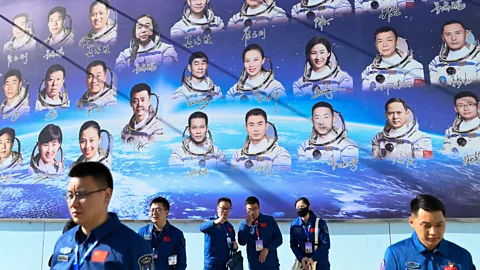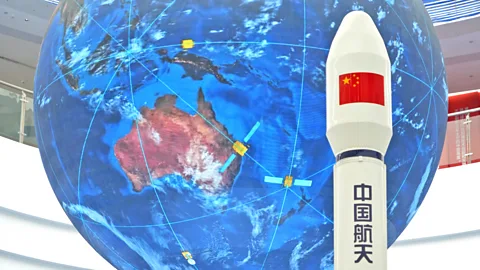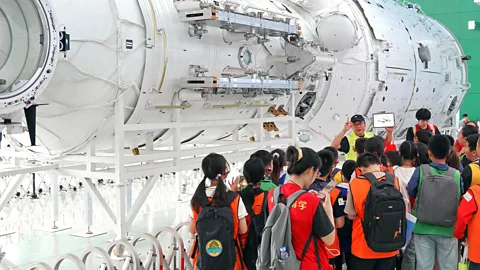Chang'e-6 is just the tip of China's ambitions for the Solar System
 Getty Images
Getty ImagesChina's Chang'e-6 mission is intended to bring back lunar samples but is also a stepping stone to much more ambitious space exploration.
China's Chang'e-6 spacecraft has landed on the unexplored far-side of the Moon and then re-launched from the lunar surface carrying precious soil samples. The probe touched down nearly one month after launching from Earth in one of China's most ambitious lunar missions to date, which sent a stack of four spacecraft towards the Moon.
While the mission marks China's growing capability in space exploration, it also offers some indications of just how far the country's ambitions within the Solar System stretch.
The main aim of Chang'e-6 is to collect the first samples from the lunar far side and deliver them safely to Earth, potentially bringing back new insights into our nearest neighbour, our own planet, and the early history of the Solar System. To do this, China's quartet of spacecraft must perform an intricate cosmic dance.
Chang'e-6 spent roughly 4.5-days on its voyage to the Moon, after launching from the Wenchang Space Launch Centre on 3 May. Once in orbit around the Moon, a lander separated from the orbiter and targeted a landing area. As the far side of the Moon never faces Earth, operations and communications with Earth were facilitated by Queqiao-2, a communications relay satellite launched by China in March.
The lander touched down in the South Pole-Aitken (SPA) basin – a huge impact crater on the far side of the Moon – in the early hours of the morning of 2 June in Beijing (22.23 1 June GMT). Safely on the lunar surface, the lander used a scoop and a drill to collect around 2kg (4.4lbs) of surface and subsurface materials. These were then sealed into a container and blasted into lunar orbit by an ascender, which will then be tasked with catching up with the orbiter and handing over its precious cargo.
The precise rendezvous and docking between orbiter and ascender will take place while travelling at just over a mile per second (1.68km per second). This will need to be automated, due to the light-time delay due to their distance from ground stations on Earth.
After this celestial game of cat and mouse, the samples will be transferred to a reentry capsule. That spacecraft – resembling a mini version of the return module of China's Shenzhou crew spacecraft – will be released just before the orbiter reaches Earth. It will first bounce itself off Earth's atmosphere to help shed some of the energy from its high-speed return from the Moon, then plummet through the atmosphere to deliver the samples to a landing area in the grasslands of Inner Mongolia.
 Getty Images
Getty ImagesGetting these samples from the SPA basin to laboratories could bring a diversity of invaluable science payoffs.
"The SPA basin is one of the best places to go on the Moon to get rocks which can be investigated to answer questions we have about the Moon's origins and geological evolution," says Katherine Joy, professor of lunar and planetary science at the University of Manchester in the UK. The rocks collected by Chang'e-6 will notably be the first from the lunar farside, while the Apollo missions conducted by Nasa all visited the nearside. "Hopefully these will help us unlock why the near and far side of the Moon are so geologically different from each other."
"The samples collected will also help us date the huge impact basin itself, shedding light on when huge planetary embryos were striking the Moon in its early history," Joy says.
Aside from the scientific intrigue however, the Chang'e-6 mission also belies some of China's even grander ambitions.
These manoeuvres will be useful practice for another possible mission: grabbing samples from Mars. While lunar samples promise big science returns in terms of Solar System secrets, Red Planet material could, potentially, provide new insights into the greatest mystery: the origins of life and whether or not Mars is habitable.
Nasa and the European Space Agency (Esa) are also working on a Mars sample return. However, that complex project has recently run into delays, budgeting issues and congressional hurdles. This means China could have a clear shot at a staggering space "first".
Another notable fact is that the complex lunar orbit rendezvous element of Chang'e-6 is not necessary for a lunar sample return. It is, however, required if you want to get astronauts to the lunar surface and safely back to Earth, and the added complexity of the Chang'e-6 mission appears to be a stepping stone to crewed lunar missions.
China announced last year that it planned to launch its first crewed lunar mission before 2030, putting a pair of astronauts on the surface for a few hours before rejoining a colleague waiting in orbit, much like the Chang'e-6 orbiter and ascender, and, most notably, similar to Nasa's Apollo missions.
China is not planning a mere short-term, flags-and-footprints presence on the Moon. Their ambition is more like Nasa's Artemis than it is Apollo. China plans to launch two separate missions to the south pole of the Moon around 2026 and 2028 – including testing using lunar soil to 3D print bricks – as precursors to a lunar base.
 Getty Images
Getty Images"The lunar south pole is the destination to be heading to to prepare for when we send humans back to the Moon," says Joy.
"Along with the Chang'e-7 and 8, several missions planned by Nasa's commercial lander programme will also be landing to test where and how much volatiles, including water and water ice, are sited in the polar soil.
"Such material could be of use by future human explorers so it will be very interesting to see what diversity will be encountered by all the planned robotic landers in the next few years."
These efforts are part of a Moon base initiative. China, together with Russia, is attempting to attract countries for a joint International Lunar Research Station (ILRS) and is developing cornerstone technology such as nuclear reactors that would provide power during the lunar nights, which last the equivalent of two weeks on Earth.
This project is a parallel yet separate initiative to Nasa's Artemis programme. It illustrates that the growing geopolitical split on Earth isn't just confined to the planet. Space exploration, sometimes seen as a purely scientific pursuit, is also a demonstration of geopolitical prowess and hints at capabilities for other goals.
China's ambitions for space are, naturally, complex. "All states pursue space projects for a variety of reasons, mostly falling within the categories of war, development, and prestige," says Bleddyn Bowen, who researches space policy and international relations in outer space at the University of Leicester.
"Some are scientific and exploratory, such as the Chang'e missions, others are for the economy and infrastructure and others are for military capabilities or force enhancement," says Bowen.
China now has its own space station, named Tiangong or "Heavenly Palace", which hosts three astronauts for periods of six months at a time. Its Beidou constellation is its answer to the United States' GPS system.
Providing timing and positioning services has triggered economic growth in China and allowed the growth of location-based app services and assisted sectors such as finance, agriculture, shipping, aviation and more. It also grants China's military with precision missile and munitions guidance capabilities and the ability to greater coordinate and project its forces across the globe. None of this is exceptional, however.
 Getty Images
Getty Images"The fact China has a military space programme and anti-satellite weapons is not out of step with what other major space powers have done in the past, and are doing today," says Bowen.
"Chinese leaders have a mix of interests in terms of war, development and prestige. They want to be secure from external and internal threats, project their own military power, secure commanding economic positions in the world economy, and reap political/prestige benefits from successes and high-profile programmes."
While major missions like Chang'e-6 grab occasional headlines, China's space programme is both comprehensive in scope and has repercussions for itself and other countries on Earth.
More like this:
• How China is creating new food in space
Back to science, China is also making strides in astronomy, astrophysics and exoplanet detection. This month, the country's key space science official revealed a series of missions that will aim to make breakthroughs. These include a constellation of satellites in formation, using the far side of the Moon as a shield against earthly interference and attempting to pick up the faint signals from the early universe.
Another mission will aim to detect Earth-like exoplanets and so-called rogue planets adrift in the Milky Way without stars to orbit, while a solar probe will attempt to get the first views of the Sun's poles.
The country's Tianwen planetary programme intends to sample a near-Earth asteroid and visit a comet, collect samples from Mars, and send a probe to Jupiter. A later mission to one of the Solar System's ice giants – either Uranus or Neptune – is being considered for the future.
Its space officials have also talked of creating an Earth-Moon economic zone, illustrating that, like other space powers such as the US, China is looking at commercialising space and its resources.
For now though, China's focus is on attempting to bring home the goods with Chang'e-6 before the end of June. Beyond this, its next sample mission, late this decade, may be carried out by its own astronauts.
* This article was originally published on 12 May 2024. It was updated on 4 June 2024 to reflect the successful landing of the Chang'e-6 on the surface of the Moon and its subsequent relaunch.
--
If you liked this story, sign up for The Essential List newsletter – a handpicked selection of features, videos and can't-miss news, delivered to your inbox twice a week.
